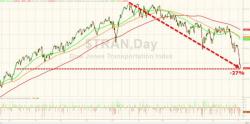10 Year Could Drop Below 2% Within Days, Citi Predicts

While equities continues to plunge in what increasingly appears to be a straight line (sorry JPM) with the occasional mini short covering rally, and are fast approaching the August 24 ETFlash crash lows, the Treasury complex has been relatively quiet. While the lack of recent buying interest may be explained with concerns over ongoing reserve liquidations by the likes of China and Saudi Arabia, if Citigroup is right, that may be about to change.


